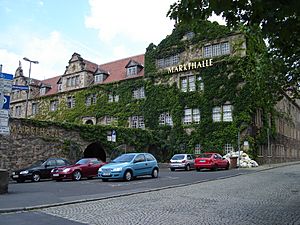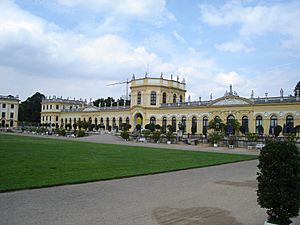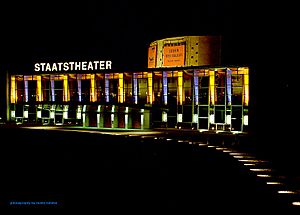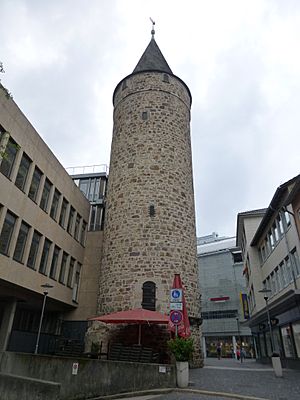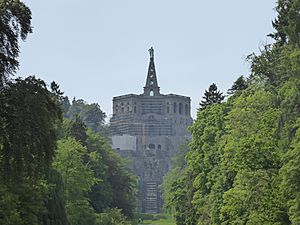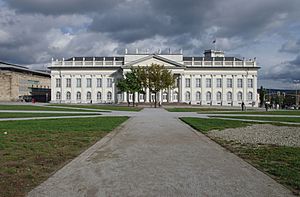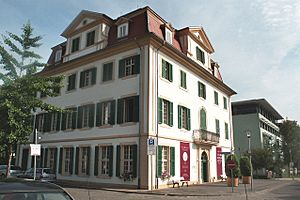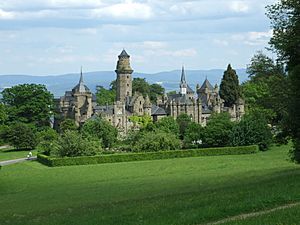Kassel facts for kids
Quick facts for kids
Kassel
|
||
|---|---|---|
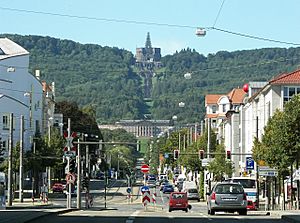
Kassel Hercules at Bergpark Wilhelmshöhe, landmark of the city (UNESCO World Heritage)
|
||
|
||
| Country | Germany | |
| State | Hesse | |
| Admin. region | Kassel | |
| District | Urban district | |
| Elevation | 167 m (548 ft) | |
| Population
(2006-12-31)
|
||
| • Total | 193,518 | |
| Time zone | CET/CEST (UTC+1/+2) | |
| Postal codes |
34001 – 34134
|
|
| Dialling codes | 0561 | |
| Vehicle registration | KS | |
| Website | www.stadt-kassel.de | |
Kassel (which was spelled Cassel until 1928) is a cool city in northern Hesse, Germany. It sits right on the Fulda River. In December 2015, about 200,507 people lived there.
Kassel used to be the capital of a state called Hesse-Kassel. It's famous for its many amazing palaces and parks. One of the most special is the Bergpark Wilhelmshöhe, which is so important it's listed as a UNESCO World Heritage Site. Kassel is also known for the documenta art shows, which feature awesome modern art!
Contents
History of Kassel
Kassel was first mentioned way back in 913 AD. King Conrad I signed some important papers there. Back then, it was called Chasella or Chassalla. It was a strong fort near a bridge over the Fulda river. We know Kassel officially became a city in 1189, but the exact date it got its city rights is a bit of a mystery!
In 1567, the area called the Landgraviate of Hesse was split among four sons. Kassel became its capital. It grew into a major center for Calvinist Protestantism in Germany. Strong forts were built to protect this Protestant stronghold from its Catholic enemies.
In 1685, Kassel became a safe place for 1,700 Huguenots, who were Protestants escaping persecution. Later, in the late 1700s, Hesse-Kassel became known for selling soldiers, called Hessians, to the British. These soldiers helped the British fight in the American Revolution. The money from this helped the local ruler build grand palaces and live a fancy life.
The Brothers Grimm and Industrial Growth
In the early 1800s, the famous Brothers Grimm lived in Kassel. This is where they collected and wrote most of their beloved fairy tales!
In 1866, Kassel joined Prussia after a war. It stopped being a princely home but quickly became a big industrial city. It was also a major railway hub. Henschel & Son, a huge company that made railway locomotives, was based in Kassel.
In 1870, after a big battle, Napoléon III was held as a prisoner at the Wilhelmshöhe Palace above the city. During World War I, the German military had its main offices in the same palace. Sadly, in the late 1930s, the Nazis destroyed the Kassel Synagogue.
Kassel During World War II
During World War II, Kassel was an important military center. A subcamp of the Dachau concentration camp was set up nearby. People were forced to work in the Henschel factories, which made tanks.
In 1943, Kassel faced a terrible bombing of Kassel in World War II. About 90% of the downtown area was destroyed. Around 10,000 people died, and 150,000 lost their homes. Most of those who died were civilians or wounded soldiers in hospitals. Interestingly, many factories survived the attacks.
In April 1945, American soldiers fought hard to capture Kassel. This caused even more damage to the city. After the war, many old buildings were not rebuilt. Instead, large parts of the city were completely new, built in the style of the 1950s. However, some historic places, like the Museum Fridericianum, were carefully restored.
Culture and Art in Kassel
Kassel has a rich cultural history! In 1558, the first German observatory (a place to study stars) was built here. Then, in 1604, the Ottoneum opened, which was Germany's first permanent theater building. Today, that old building is a Natural History Museum. The current Staatstheater Kassel is in a newer building nearby.
Since 1927, Kassel has been home to Bärenreiter, one of the world's most important music publishers.
Documenta Art Exhibition
Since 1955, Kassel has hosted the Documenta. This is a huge international exhibition of modern and contemporary art. It happens every five years and attracts artists and visitors from all over the world.
After the Documenta in 1977, Kassel became the first city in the world to be lit up by laser beams at night! You can still see this laser show on weekends. You'll also find many other cool art pieces, especially sculptures, from past Documenta shows all around Kassel.
Amazing Sights in Kassel
Because of the bombing raids in 1943, 90% of Kassel's city center was destroyed. The city was mostly rebuilt in the 1950s. So, you'll see a mix of old, restored buildings and 1950s architecture. Outside the city center, many areas have buildings from the 1800s.
The oldest monument still standing is the Druselturm. The Brüderkirche and the Martinskirche also have parts that are from medieval times. The towers of the Martinskirche, however, were built in the 1950s.
Bergpark Wilhelmshöhe: A World Heritage Site
Bergpark Wilhelmshöhe is a massive park in Kassel. It covers 2.4 square kilometers, making it the largest hillside park in Europe and the second largest in the world! This amazing park includes the Wilhelmshöhe Palace, the famous Hercules monument, and the Lions Castle. In 2013, this entire complex was named a UNESCO World Heritage Site.
Wilhelmshöhe Palace was built in 1786. Today, it's a museum with an important collection of ancient Greek and Roman art. It also has a fantastic art gallery with the second-largest collection of Rembrandt paintings in Germany!
The Hercules Monument and Water Features
The Hercules monument is a giant stone structure shaped like an octagon. On top, there's a huge copy of the famous Hercules "Farnese" statue.
From the base of the Hercules monument, a long series of artificial waterfalls and cascades flow down towards Wilhelmshöhe Palace. These are super fun to watch in the summer! Every Sunday and Wednesday afternoon from May to October, the famous water features show takes place. It starts at the Oktagon (the base of Hercules). You can follow the water's path for about an hour as it tumbles down through the park. The show ends at the lake near Wilhelmshöhe Palace, where a fountain shoots water about 50 metres (160 ft) high!
Other Parks and Castles
The Löwenburg (which means "Lions Castle") is a cool replica of a medieval castle. It was also built when Wilhelm IX was in charge. After the Franco-Prussian War in 1870-71, Napoléon III was held here.
Another big park is the Karlsaue, which is part of the European Garden Heritage Network. It's located along the Fulda River. This park was created in the 1500s and is famous for its Orangerie, a palace built in 1710. Today, the Orangerie houses the Museum of Astronomy and Technology. It even has a model of our Solar System that stretches across the entire park and beyond!
Kassel also has the Park Schönfeld, which includes a small, local botanical garden called the Botanischer Garten Kassel.
Art Museums in Kassel
- The Museum Fridericianum was Europe's first public museum, founded in 1779. By the late 1800s, it had one of the world's biggest collections of watches and clocks!
- Wilhelmshöhe Palace (This museum has ancient art and paintings by famous artists like Albrecht Dürer, Rubens, Rembrandt, and Frans Hals).
- New Gallery (Features art by the Tischbein family and Joseph Beuys).
- Hessisches Landesmuseum (Known for its amazing wallpaper collection).
Other Cool Museums
- Museum of Natural History (located in the Ottoneum building).
- Museum of physics and astronomy (in the Orangerie).
- Marmorbad (a marble bath, also in the Orangerie).
- Caricatura (a museum for cartoons and caricatures, in the Hauptbahnhof Kassel).
- Museum of Local History.
- Tram-Museum Kassel.
- Technical Museum and Henschel Museum.
- Louis Spohr Museum (about a famous classical music composer).
- Brothers Grimm Museum (in the Bellevue Palace).
- Museum for Sepulchral Culture (about burial customs).
- Museum of the Brothers Grimm (also known as Grimmwelt Kassel).
- Museum of Modern Art (Neue Gallerie).
- Gemäldegallerie Kassel (Art Gallery) in the Wilhelmshöhe Palace (Schloss Wilhelmshöhe).
- Botanical Island (Insel Siebenbergen).
Images for kids
-
The Brothers Grimm and historic buildings of Kassel on the old 1000 DM banknote
See also
 In Spanish: Kassel para niños
In Spanish: Kassel para niños




